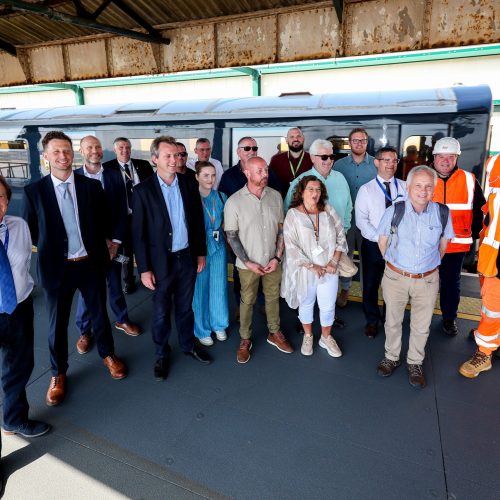You know an innovation is good when it starts to stick. You know a project is successful when the benefits extend beyond enhanced infrastructure. As Octavius hands back Ryde Pier to South Western Railway, enabling the first trains to run in eight months, the team leaves a legacy of innovation and social value.
Ryde Pier extends half a mile into the Solent and, in essence, connects mainland rail services in Portsmouth with the Isle of Wight’s Island Line; by allowing rail passengers crossing the Solent by ferry to swiftly disembark and board rail services. Customer Network Rail, awarded Octavius the design and build contract to entirely repair and refurbish all of the pier’s track-related infrastructure – with completion due within nine months.
Innovation brings speed and value
With the clock ticking the team used an innovative approach to accessing the track and supporting structure that saved both time and money – adopting a tensioned access platform (TAP) instead of traditional scaffolding. Slung beneath the pier the robust system gave access to the work area, prevented people from falling, and caught any loose material. Ryde Pier is believed to be the first marine application of TAP on a UK rail project, and only the second time the system has been used on a Network Rail scheme. It is unlikely to be the last though, as the team is already being asked about the system’s potential for other rail projects; while the Marine Management Organisation also showed an interest in Octavius’ application of TAP technology.
Where there was no alternative to scaffolding Octavius worked with nature, floating pre-assembled spans into position on pontoons, then using the high tide to raise the assembly up to the pier’s underside.
To enhance longevity in the hostile marine environment fibre-reinforced foamed urethane sleepers and glass reinforced plastic waffle board replaced wooden materials. A truly multi-disciplinary project – however – as well as civils and track work Ryde Pier also called upon Octavius’ electrification and signalling expertise for the replacement of the entire signalling system.
Overcoming access challenges
For all elements of the project access, on a linear marine structure, presented challenges. Removing old woodwork and track required barges. In the absence of a rail access point close to the site, efficiently bringing new track, sleepers, signalling equipment and other materials on to the pier meant creating a new rail access point in close proximity to the structure.
Originally intended as temporary works, the new access point was deemed sufficiently valuable for Network Rail to request it be established as a permanent asset. This is one instance of the local legacy left by Octavius. Another is the expansion of marine contractor Rebel Marine’s workboat services to other rail projects, based upon their support for this and Octavius’ previous work on the pier. Other beneficiaries include local hoteliers who have enjoyed a steady stream of out of season bookings, sometimes running up to 60 people working on the pier project.
For the Octavius team there is the satisfaction of an interesting, rewarding project delivered ahead of schedule and on budget – allied to the pleasure of seeing the trains running along the pier once more.
Access Our Growing Resource Centre
Stay informed with regularly updated resources and insights designed for professionals driving accessible rail projects. Access key reports and practical guidance to support your AfA projects. With insights into proven practices, compliance requirements and in depth summaries from InnovateUK and the House of Commons, the AfA resource centre is your starting point for delivering inclusive rail infrastructure.
Our collection is continuously growing—sign up now to stay informed as new resources are added.

